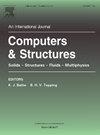Rapid optimization of rocket projectile tailfins based on multi-fidelity neural networks with transfer learning
IF 4.8
2区 工程技术
Q1 COMPUTER SCIENCE, INTERDISCIPLINARY APPLICATIONS
引用次数: 0
Abstract
The aerodynamic characteristics of a rocket projectile have a direct impact on its flight performance, with tailfins playing a crucial role. Optimizing the tailfin shape is therefore a key focus in rocket projectile design. However, traditional optimization methods based on computational fluid dynamics (CFD) are time-consuming and inefficient. To address this, the study introduces a multi-fidelity fully connected neural network model based on transfer learning (MFFCN-TL) and applies it to the aerodynamic optimization of a 122 mm rocket projectile. The MFFCN-TL model was pre-trained on 1100 low-fidelity CFD samples and fine-tuned with 80 high-fidelity samples to predict the lift coefficient, drag coefficient, and pressure center, with Monte Carlo Dropout used to quantify uncertainty. The prediction performance of MFFCN-TL was first evaluated against several surrogate models, followed by single-objective and multi-objective optimizations of the tailfin design. In single-objective optimization, the goal was to maximize the lift-to-drag ratio by enhancing Bayesian optimization with a heteroscedastic Gaussian process and an improved upper confidence bound acquisition function, enabling the use of model uncertainty to guide the optimization process and balance exploration and precision. Multi-objective optimization employed multi-objective Bayesian optimization (MOBO) and the non-dominated sorting genetic algorithm II (NSGA-II) to balance the lift-to-drag ratio and drag coefficient, offering comprehensive design trade-offs. The results demonstrate that MFFCN-TL achieved determination coefficients of 0.9224, 0.9912, and 0.9688 for the drag coefficient, lift coefficient, and pressure center, respectively, surpassing other models. This method increased the lift-to-drag ratio by 37%, delivering optimization results comparable to CFD-based methods, while shortening the optimization time to 17.5 days from 26.5 days required by CFD. Multi-objective optimization produced a Pareto front and were validated by CFD simulations, confirming the reliability of the model. This approach provides an efficient and reliable solution for rapid tailfin design, significantly reducing computational cost while maintaining high accuracy.
基于迁移学习的多保真度神经网络的火箭弹丸尾翼快速优化
火箭弹的气动特性直接影响其飞行性能,其中尾翼起着至关重要的作用。因此,优化尾翼形状是火箭弹丸设计的一个重点。然而,传统的基于计算流体力学(CFD)的优化方法耗时且效率低下。为了解决这一问题,本文引入了基于迁移学习的多保真度全连接神经网络模型(MFFCN-TL),并将其应用于某122毫米火箭弹的气动优化。MFFCN-TL模型在1100个低保真CFD样本上进行了预训练,并在80个高保真样本上进行了微调,以预测升力系数、阻力系数和压力中心,并使用Monte Carlo Dropout对不确定性进行了量化。首先对MFFCN-TL的预测性能进行了几种替代模型的评估,然后对尾翼设计进行了单目标和多目标优化。在单目标优化中,通过异方差高斯过程和改进的上置信度采集函数增强贝叶斯优化,实现升阻比最大化,利用模型不确定性指导优化过程,平衡探索和精度。多目标优化采用多目标贝叶斯优化(MOBO)和非主导排序遗传算法II (NSGA-II)来平衡升阻比和阻力系数,进行全面的设计权衡。结果表明,MFFCN-TL模型对阻力系数、升力系数和压力中心的确定系数分别为0.9224、0.9912和0.9688,优于其他模型。该方法将升阻比提高了37%,优化结果与CFD方法相当,同时将优化时间从CFD所需的26.5天缩短至17.5天。多目标优化得到了Pareto前沿,并通过CFD仿真验证了模型的可靠性。该方法为快速尾翼设计提供了高效可靠的解决方案,在保持高精度的同时显著降低了计算成本。
本文章由计算机程序翻译,如有差异,请以英文原文为准。
求助全文
约1分钟内获得全文
求助全文
来源期刊

Computers & Structures
工程技术-工程:土木
CiteScore
8.80
自引率
6.40%
发文量
122
审稿时长
33 days
期刊介绍:
Computers & Structures publishes advances in the development and use of computational methods for the solution of problems in engineering and the sciences. The range of appropriate contributions is wide, and includes papers on establishing appropriate mathematical models and their numerical solution in all areas of mechanics. The journal also includes articles that present a substantial review of a field in the topics of the journal.
 求助内容:
求助内容: 应助结果提醒方式:
应助结果提醒方式:


